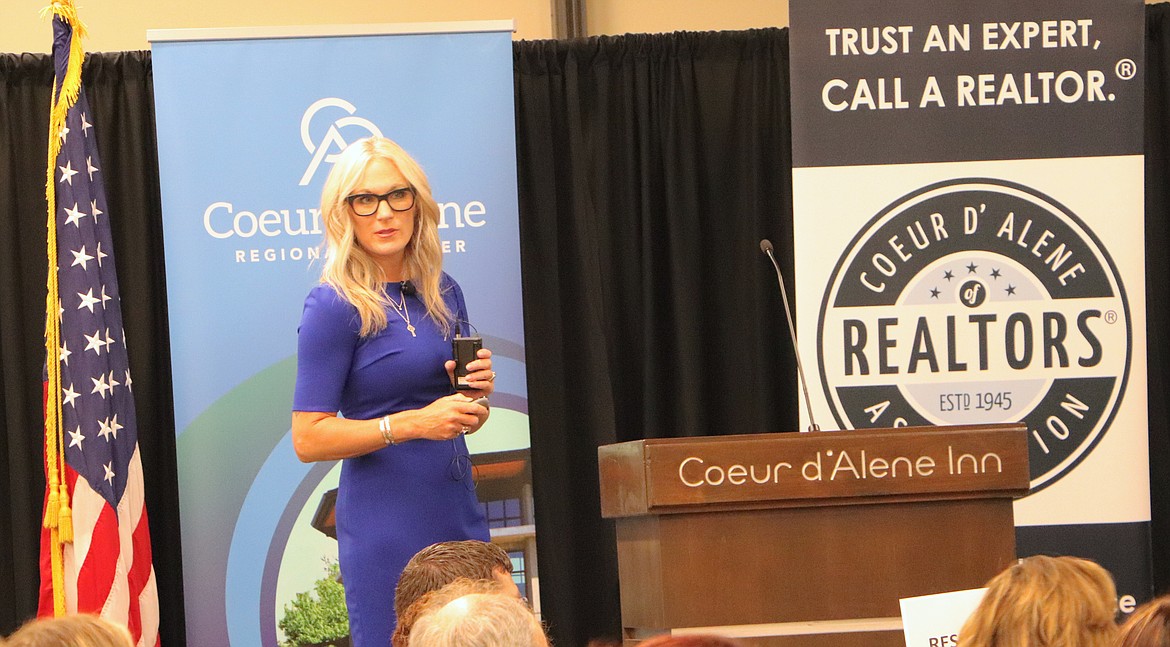Real estate realities in the Wild, Wild West
In front of a crowd of 200 people Thursday morning, Kootenai County Community Development Director David Callahan compared the aftermath of COVID-19 to the likes of World War II.
Attendees of the Coeur d’Alene Regional Chamber of Commerce and Coeur d’Alene Association of Realtors event, “Navigating the Wild Wild West — the Growth of Kootenai County” likely didn’t expect to receive the mass of information provided by notable speakers.
Featuring Association President Kristen Johnson of CENTURY 21 Beutler & Associates, Jennifer Smock of Windermere/Coeur d’Alene Realty, Airport Director Steven Kjergaard and Callahan, speakers gave a midyear update on the regional housing market.
Doing what he never does, Callahan went off script. He relayed to the audience his personal experience navigating the last 18 months, comparing the national and local impacts of COVID-19 to the fallout of World War II.
“We have been traumatized to some extent, and we’re still recovering,” Callahan said. “In the years after World War II, like today, there was a labor and a housing shortage, and the European economy was decimated.”
Pointing to a presentation slide titled “It’s brutal out there,” Callahan noted that prices are up 30% to 50% year over year, shattering former records.
Nodding to previous data shared by Smock, inventory — while slowly climbing back up — is still down by almost 70% from this time last year.
In the four major areas — Coeur d’Alene, Post Falls, Hayden, and Rathdrum — the median sales price for a home has increased between 35% and 44% since 2020, Smock said. Notably, premier properties with price points in the millions have experienced record sales, jumping from 26 closed sales in 2019 to 24 in 2020, yet already at 144 so far this year — which isn't half over.
Today, Smock and other Realtors find that if a buyer isn't qualified to afford a $350,000 home, there is “nothing to buy.”
“That’s a really tough pill to swallow for a lot of individuals,” she said.
Smock noted that the increase isn’t driven by the real estate agent but by a lack of inventory and people who are willing to bid over the listed price.
Kootenai County’s growing population is somewhat to blame, but Callahan pointed out that “growth” isn’t new to the area. It's just happening faster than before, and the secret utopia of North Idaho broadcast in the national media isn’t helping, Smock said.
If she had to estimate, Smock said the ratio of out-of-state buyers to Idahoans is about 60/40, only slightly tilted on the side of newcomers. Most of them are looking to buy a second home and pay with cash, she noted.
“It’s a different market than we have ever seen. It’s hard, it’s challenging, it’s a struggle. There is not enough inventory,” Johnson told The Press. “It is wild out there in this fast-paced, hot market. Now more than ever, you need your Realtor partner to assist you in the process.”
Johnson said the focus is to get more listings and “beef up” inventory to feed the beast of supply and demand. Still, while she is hopeful, she doesn’t know when the inventory issue will get better.
Inventory, both new construction and existing homes, has declined for a variety of reasons. For existing properties, historically low interest rates are encouraging homeowners to stay and invest, she said.
On the new construction side, developers have been restricted by a backlog of permit applications and the skyrocketing costs of materials like lumber — which have risen by more than 250% since last April, according to the National Association of Home Builders.
All these points aside, Smock encouraged attendees that Kootenai County is not heading for a housing bubble. On Thursday, she said there had been 24 properties with price reductions, and with increasing frequency, buyers are pushing back against overshot list amounts.
“We’re all scared. It’s an unpredictable time, so we all worry,” Smock said. “My advice to anyone would be to keep their equity in their home, sit this out, and see what happens.”
Callahan was hopeful, but much of his faith stems from the Regional Housing and Growth Partnership of elected and planning officials throughout the area. He believes the best way to face growth is to look at solutions that benefit the entire community.
“If we don’t approach it that way, we end up with a zero-sum game — that’s a game-strategist term where for every winner, there is a loser,” Callahan said.
What saved global powers after WWII, and what Callahan believes will save Kootenai County now, is coming up with out-of-the-box ideas. Pointing to historic actions like the Marshall Plan — also known as the European Recovery Plan — and creation of the United Nations, Callahan said it would take a community willing to pull together to rise above the COVID-induced rut.
“I hope (audience members) find in themselves the courage of Churchill and the compassion of Mother Teresa so that we can come together and pull through this,” Callahan told The Press. “I’m hopeful that we as a community find that common cause because we need to.”



